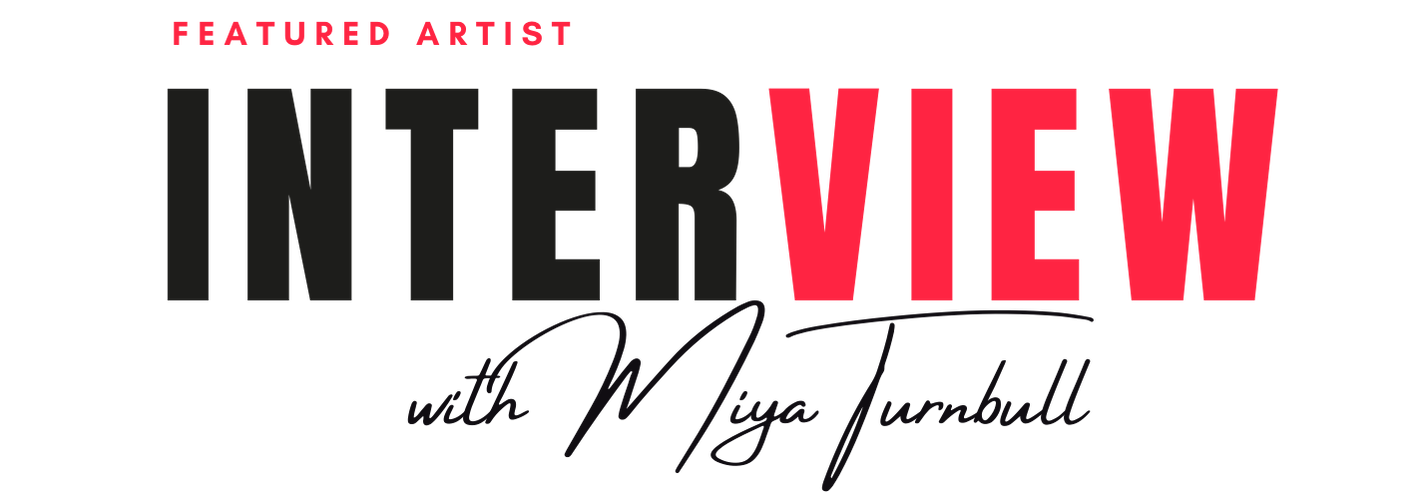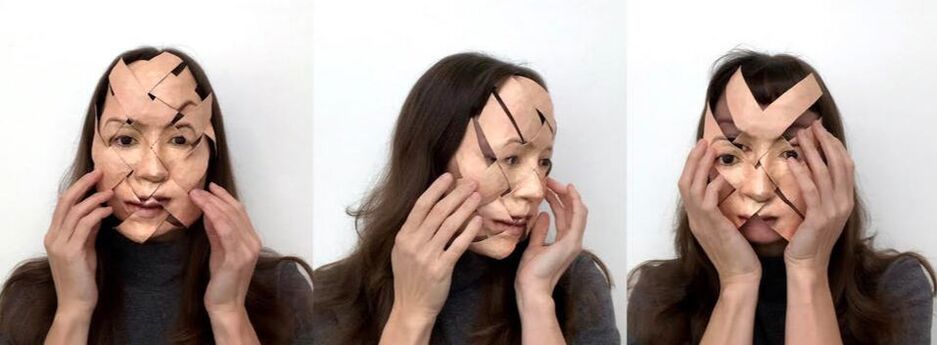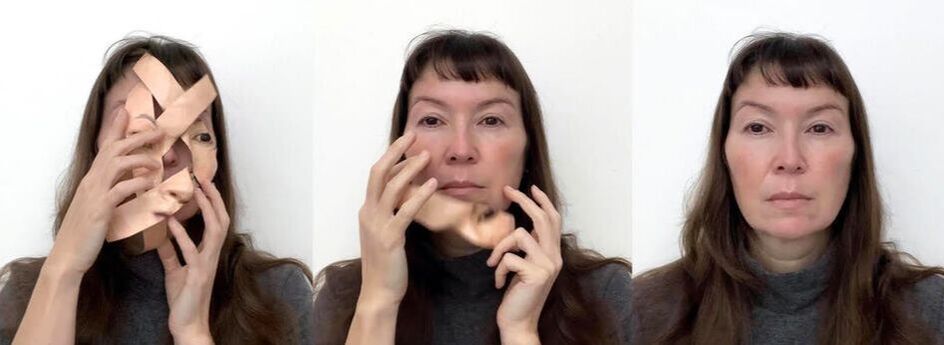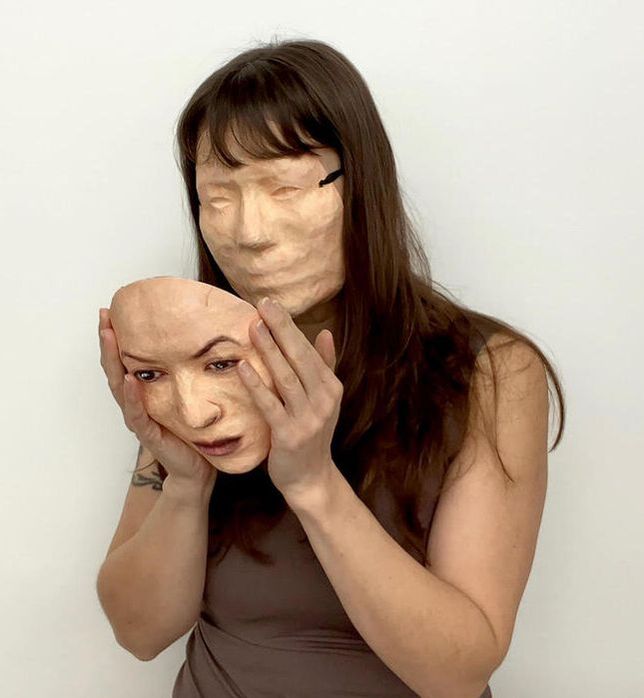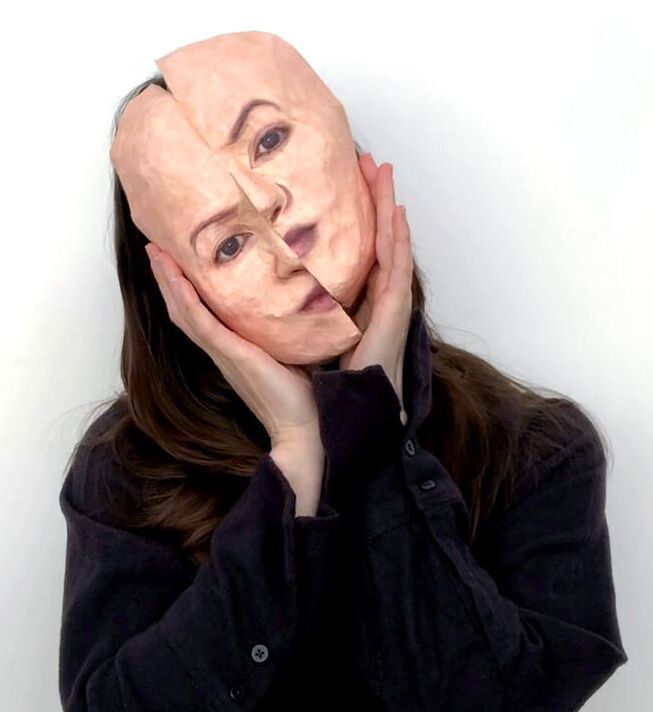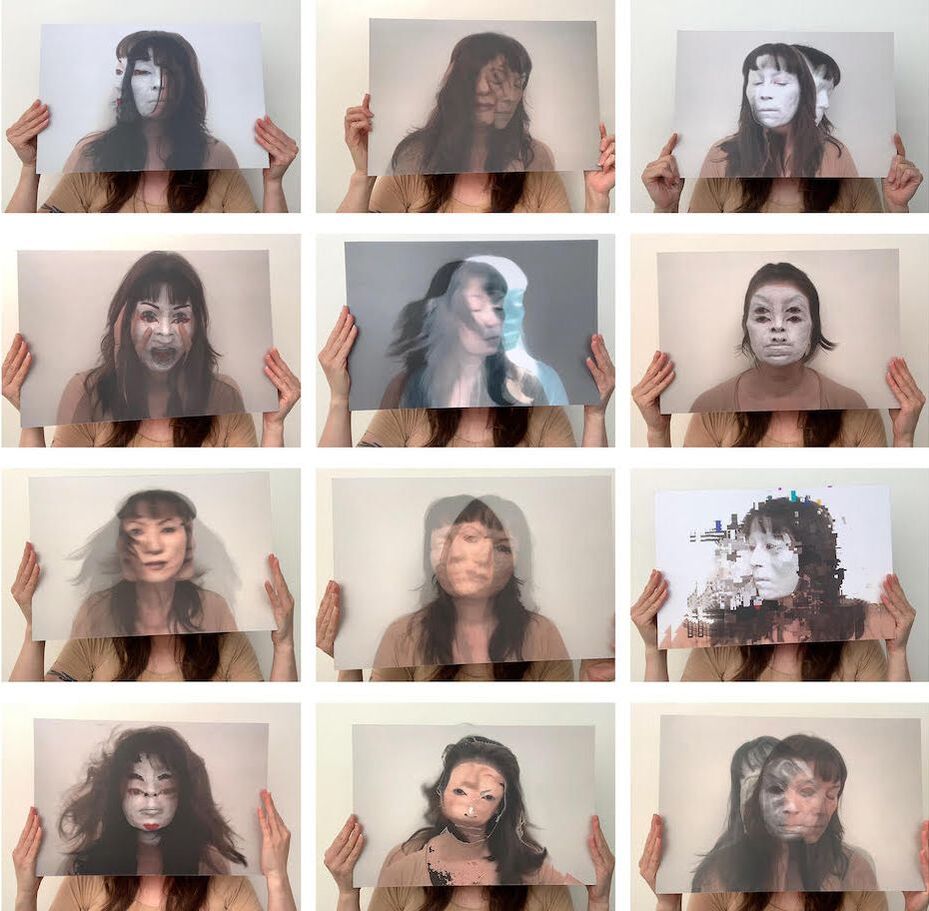By C.T. Lisa | October 2021
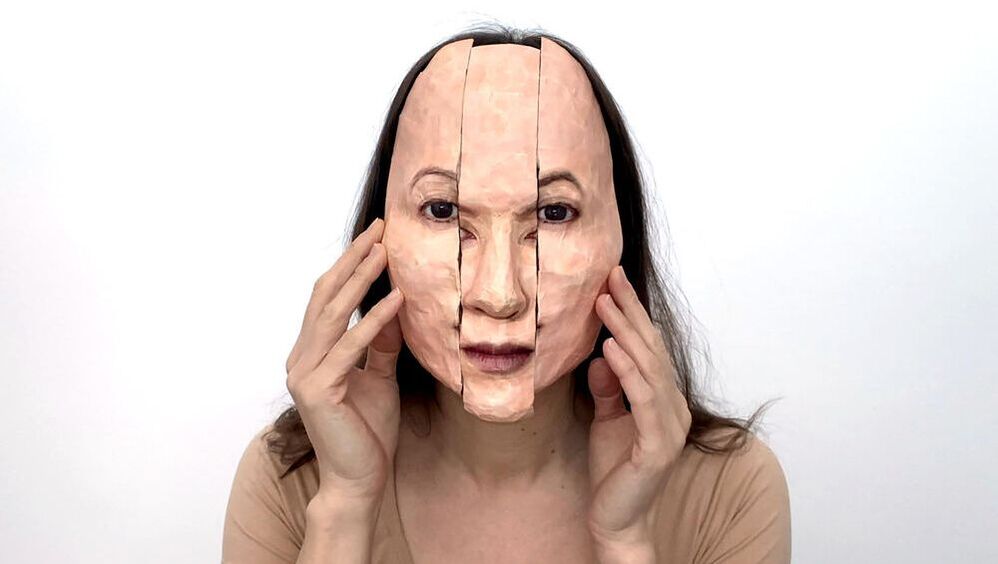 "Self-Portrait (Shift #8) by Miya Turnbull | Aesthetica Magazine | Aug/Sept 2021
"Self-Portrait (Shift #8) by Miya Turnbull | Aesthetica Magazine | Aug/Sept 2021
Miya Turnbull is a Canadian multidisciplinary visual artist. Primarily a mask maker, she also works in painting, photography, screen printing, textiles, video, animation, and projection. She works predominantly with self-portraits as a way to explore and examine identity, persona, and self-image. She has exhibited across Canada and internationally, and she is the recipient of numerous grants. Turnbull currently lives in Mi'kma'ki (Nova Scotia).
When did you know you wanted to be an artist?
I was always drawing when I was a kid and would say I wanted to be an artist when I grew up. In high school, I developed a passion for it, realized I had some skill, and was encouraged by my teacher, Ms. Linda Lawrence, who I found really inspiring. At one point, she gave us clay to make a mask, which I had never done before.
Art really helped me through some difficult times. In University I changed my major several times before completing my Bachelor's of Fine Art, even though I was skeptical of how to make a living by making art. It's only been in the past few years that I would say I'm an artist without feeling like an imposter. Making art full-time and getting exhibits and grant funding helps to validate that, but it shouldn't have to.
Art really helped me through some difficult times. In University I changed my major several times before completing my Bachelor's of Fine Art, even though I was skeptical of how to make a living by making art. It's only been in the past few years that I would say I'm an artist without feeling like an imposter. Making art full-time and getting exhibits and grant funding helps to validate that, but it shouldn't have to.
For those of us who aren't familiar with mask making, can you tell us a bit about your practice? What drew you to this medium?
It's not a very common medium, but you'd be amazed how many mask makers are out there now! It combines a lot of things that I love—sculpture, photography and collage. I took a class in university through the drama department, learning basics like casting my face and using paper-mâché to make lightweight but strong masks. Then I began developing my Photo Mask technique in my independent studio classes, which I continue to use in my practice, starting with a self-portrait. Using photos for the final layers of the masks brought life to them. [It] was instantly realistic yet uncanny. It was very gratifying, and I knew I was on to something!
I love masks as ornamental art pieces but also as something I can wear to cover my face and change the way I look, so it touches on performance art too. I animate and do projections with the masks as well, so that gets into new media and digital work. I love that [mask making] intersects with so many different disciplines.
Masks are the perfect metaphor for representing identity. Masks come with such a rich history, tradition, and so much meaning. It almost feels like cheating in a way, because when I make new masks, I'm drawing from all the significance already imbued. But I like to think I'm also pushing the medium further in several ways. So I carry all that symbolism in my work, and then use it to dig deeper into my explorations.
I love masks as ornamental art pieces but also as something I can wear to cover my face and change the way I look, so it touches on performance art too. I animate and do projections with the masks as well, so that gets into new media and digital work. I love that [mask making] intersects with so many different disciplines.
Masks are the perfect metaphor for representing identity. Masks come with such a rich history, tradition, and so much meaning. It almost feels like cheating in a way, because when I make new masks, I'm drawing from all the significance already imbued. But I like to think I'm also pushing the medium further in several ways. So I carry all that symbolism in my work, and then use it to dig deeper into my explorations.
I'm struck by the variations of tone in your work. Each mask evokes a nuanced tone--campy, creepy, flippant, etc. Where do the faces come from?
I don't necessarily set out to capture a certain tone. Mostly I'm just experimenting with different variations; one idea leads to another, and I usually have to exhaust the variations before I move on to the next. They are all self-portraits, even if they get completely abstracted in the process of trying out different techniques.
For example, if I've learned a new sewing technique or Japanese calligraphy, it's not long before it gets incorporated into my masks in some way. Or if I'm shifting my face on top of the mask structure in one way, then I also need to try other similar ways. I might discover a new material to work with, and the potential of that leads to new faces.
But my face is always the constant in some form, whether it's the shape of the face or the photo that I'm using. There's always some tether and something familiar threaded through all the faces--even though my collection of masks has now grown to over 100! I like to keep them as a group for exhibits and have the viewers see them all together to paint a bigger picture--I want them to see all the different faces as variations of "me." Or even more abstractly, I want them to see "me" in the space between them all. And even though the masks are self-portraits, I want the viewers to actually see themselves in that space too. That's a lot to ask though, I know.
For example, if I've learned a new sewing technique or Japanese calligraphy, it's not long before it gets incorporated into my masks in some way. Or if I'm shifting my face on top of the mask structure in one way, then I also need to try other similar ways. I might discover a new material to work with, and the potential of that leads to new faces.
But my face is always the constant in some form, whether it's the shape of the face or the photo that I'm using. There's always some tether and something familiar threaded through all the faces--even though my collection of masks has now grown to over 100! I like to keep them as a group for exhibits and have the viewers see them all together to paint a bigger picture--I want them to see all the different faces as variations of "me." Or even more abstractly, I want them to see "me" in the space between them all. And even though the masks are self-portraits, I want the viewers to actually see themselves in that space too. That's a lot to ask though, I know.
One of the things that especially caught my eye are what you refer to on your website as "Woven Masks." Can you talk a little about how these are constructed and how they differ from the rest of your body of work?
I love these masks so much. Each mask consists of two individual masks cut up into strips and then interlaced or woven together. Definitely a challenge, since the paper-mâché strips were quite rigid, so it was hard to keep them in place and also not break them--which happened many times. I would often need extra hands to construct them, so my daughter was often called in to help.
I love the glitchy look the two masks created together, since they didn't line up perfectly. The really cool thing about these masks was that once the pieces were in place, they held themselves together briefly by the tension of the strips against each other.
This also opened up an opportunity for performance. I could wear these masks while filming and soon the mask would fall apart. That seemed so meaningful all on its own, especially during the pandemic. My face was revealed underneath--defenseless and unprotected. And vice versa--playing a video of this footage backwards--was a way to create a facade building itself on my face. Eventually I did glue the pieces together, but they never seemed to look as interesting as those first masks that weren't fixed in place.
I love the glitchy look the two masks created together, since they didn't line up perfectly. The really cool thing about these masks was that once the pieces were in place, they held themselves together briefly by the tension of the strips against each other.
This also opened up an opportunity for performance. I could wear these masks while filming and soon the mask would fall apart. That seemed so meaningful all on its own, especially during the pandemic. My face was revealed underneath--defenseless and unprotected. And vice versa--playing a video of this footage backwards--was a way to create a facade building itself on my face. Eventually I did glue the pieces together, but they never seemed to look as interesting as those first masks that weren't fixed in place.
From the outside, it seems like your work is a pretty labor-intensive process. Do you spend a lot of time planning out masks before putting in the effort to execute them? Or do you improvise, follow your intuition?
Some of the masks are planned out initially--sometimes I see something very clearly in my mind, or I've gotten ideas from the last mask that I made and can't wait to try another variation. But sometimes I'm stuck for ideas, and then I'll just start the process anyway, not sure of where it will go. Often I try something on the mask that makes me cringe or that I find interesting, and then I go with that.
Your work explores "where the outer persona turns inward or where the line between 'beauty' and 'grotesque' becomes blurred." Do you see your work primarily as an exploration of authenticity?I wouldn't say that I'm primarily exploring authenticity, but that's definitely something I am exploring, especially when it comes to comparing the outer persona--the face we show the world—in contrast to our inner world. Sometimes I show contrast between the two by misaligning my features on the mask, where the surface of the mask doesn't match the structure. Or I will depict a different face or expression on the concave space inside the mask.
In that statement, I am more interested in exploring that "in-between" space, whether it's between the outer and inner, or that shift between beauty and grotesque and also between two cultures, since I am a mix of Japanese-Canadian/Caucasian. |
How has your work changed with the advent of the coronavirus pandemic? Do things like 'mask mandates' have any impact on your work, your inspiration?
It is such an interesting time to be a mask maker, that's for sure. All of a sudden, there is such a spotlight on masks, and almost everyone globally knows now what it feels like to wear a mask. I watched the reaction with great interest and a lot of dread. I couldn't believe the amount of resistance the western world had when being asked to wear a piece of cloth over their mouth and nose in order to protect each other.
The first thing I did when the pandemic hit was to set up my sewing machine. I made fabric masks for months on end for anyone that wanted one. I didn't even charge any money--I just wanted people to be safe. And I tried to teach mask hygiene along with it, because it's also alarming how people are treating their masks! I love seeing most people embrace wearing masks, and then even more delighted when I see people decorating their masks as an accessory to show their personality and individuality.
[During COVID] I did start looking at and thinking about masks differently. I began to see them as symbols for protection, which I hadn't before, in addition to masquerade, disguise, and transformation.
A lot of interesting things have come out of the pandemic regarding mask wearing--I see how much we value seeing each other's faces for connection, communication, and reading emotions. It's interesting to focus on faces so much in my art. A benefit of masks (besides keeping COVID at bay) is the relief some people feel not having to partake in beauty standards, such as wearing make up and/or shaving, etc., or even "having" to show certain expressions when they don't feel like it. But the most interesting thing to me is how it feels to wear a mask out and about. I think I'm invisible to some extent and am always surprised when I'm recognized.
It wasn't long before my COVID masks overlapped with my art practice. I started making half-masks out of papier-mâché. I mimicked the pleated surgical mask with my photo on it. Then I began new series such as the Woven one mentioned previously, where I see myself without a mask as vulnerable and exposed, and I'm sure it's worked itself into my work in ways I haven't even realized yet. I've worked excessively during the pandemic as a way to cope with stress and not being able to travel to be with my family... so on the positive side of things, it's been a very productive year-and-a-half for me, and I've received a lot of attention as a mask maker, which is exciting.
The first thing I did when the pandemic hit was to set up my sewing machine. I made fabric masks for months on end for anyone that wanted one. I didn't even charge any money--I just wanted people to be safe. And I tried to teach mask hygiene along with it, because it's also alarming how people are treating their masks! I love seeing most people embrace wearing masks, and then even more delighted when I see people decorating their masks as an accessory to show their personality and individuality.
[During COVID] I did start looking at and thinking about masks differently. I began to see them as symbols for protection, which I hadn't before, in addition to masquerade, disguise, and transformation.
A lot of interesting things have come out of the pandemic regarding mask wearing--I see how much we value seeing each other's faces for connection, communication, and reading emotions. It's interesting to focus on faces so much in my art. A benefit of masks (besides keeping COVID at bay) is the relief some people feel not having to partake in beauty standards, such as wearing make up and/or shaving, etc., or even "having" to show certain expressions when they don't feel like it. But the most interesting thing to me is how it feels to wear a mask out and about. I think I'm invisible to some extent and am always surprised when I'm recognized.
It wasn't long before my COVID masks overlapped with my art practice. I started making half-masks out of papier-mâché. I mimicked the pleated surgical mask with my photo on it. Then I began new series such as the Woven one mentioned previously, where I see myself without a mask as vulnerable and exposed, and I'm sure it's worked itself into my work in ways I haven't even realized yet. I've worked excessively during the pandemic as a way to cope with stress and not being able to travel to be with my family... so on the positive side of things, it's been a very productive year-and-a-half for me, and I've received a lot of attention as a mask maker, which is exciting.
One of our goals at MASKS is to champion the work of emerging writers and artists--do you have any advice for people out there trying to sustain a creative practice?My advice would be to work at something daily, or as regularly as possible. Even just five minutes a day will amount to something substantial over time. And apply for everything--submit to grants, exhibits, publications, and any opportunity possible. For every "yes" I get, there are at least five rejections, so you do need to develop a thick skin, BUT if I didn't apply to anything, nothing would happen.
It's definitely hard to maintain creativity, especially during a pandemic or stressful situations, so be kind to yourself. Whenever I get stuck I try and learn something new, and eventually something clicks. Also, I just start the process and try things out, even if I have no idea where to go with it. If I don't like the results, I just cover it over with another idea. |
Where else can we find your work?
I post most regularly on Instagram @miyamask and I try to keep up with my website www.miyaturnbull.com, which is full of photos and videos and information. My last major exhibit just finished at the end of August at Gallery 101 in Ottawa, Ontario. I'm hoping to line up more shows in the future, so right now I'm taking advantage of social media to post new work.
